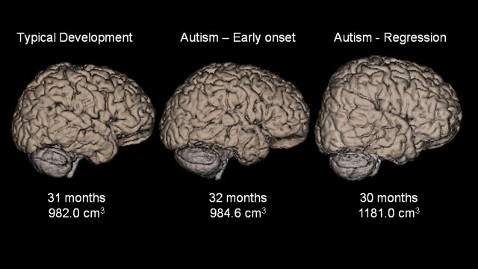Bigger Brains in Certain Types of Autism, Study Finds

Representative brain scans of boys at approximately 30 months old. Image Credit: Courtesy of Aaron Lee
A new study adds to an increasing amount of evidence suggesting a link between brain size and autism.
Researchers at the Mind Institute at the University of California at Davis have found that children with a certain type of autism, called regressive autism, generally have larger brains than children without the disorder, and for kids with early onset autism.
A number of recent studies have found a link between brain size and autism, confirming suspicions long held by many autism experts that the disorder is linked to neurological growth and development. But the authors of this latest study, David G. Amaral and Christine Wu Nordahl, say their findings, published in the Proceedings of the National Academy of Sciences, indicate that the causes of autism may vary among children with different types of the disorder.
The researchers used magnetic resonance imaging to study the brains of 180 children, ages 2 to 4, and analyzed the records of head circumference taken throughout the life of each child. Of those children, 61 had regressive autism, a form of autism in which children seem to develop normally until about 18 to 24 months, when they begin to lose the language and social skills they’d already acquired. Of the study’s remaining children, 53 had early onset autism and 66 did not have autism at all.
The researchers found that boys with regressive autism had 6 percent more brain volume than their peers who didn’t have autism at all; the brains of boys with early onset autism were similar in size to the brains of nonautistic children.
Amaral said the findings shed light on the complexity of autism and its many subgroups, which he and his colleagues are trying to understand through a long-term study of autistic children. He said that only about 10 percent of the children in the current study had larger brains.
”There’s enormous heterogeneity in the disorder, and there’s a lot of kids with characteristics that overlap with kids who develop normally,” Amaral said. “This study confirms the idea that big brains are one scenario of autism, but it’s not the only scenario.”
Adding even more complexity to their findings, the researchers found that brain size differences seemed to be tied to gender. All the autistic girls in the study, even those with regressive autism, showed no difference in brain size than their nonautistic peers.
Autism is four times more likely to occur in boys than in girls, according to the U.S. Centers for Disease Control and Prevention, but scientists know very little about the neurological underpinnings of this gender difference.
The study adds to a growing chorus of research suggesting that abnormal brain growth plays a crucial part of the development of autism.
“It’s important to remember that not all kids with autism have the same form of brain pathology,” Nordahl said. “We need to keep looking for these different subgroups of autism so we can better target our treatments for the disorder.”